Double-decker microwaving for a donburi thermal jar lunch
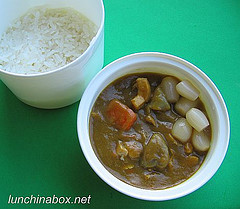 At first glance this may not seem like a particularly interesting lunch, but I’ve actually taken a couple of new approaches to packing that can be applied to other dishes.
At first glance this may not seem like a particularly interesting lunch, but I’ve actually taken a couple of new approaches to packing that can be applied to other dishes.
Morning prep time: 6 minutes, using leftover curry and rice. In the morning I microwaved the rice and curry in microwave-safe ceramic bowls while preheating the outer thermal food jar with hot tap water. Preheating the outer thermal jar helps the container retain heat longer, keeping your food nice and warm.
Gear: Although microwave ovens are usually a pretty good size on the inside, the limiting factor on how much food I can warm at once is usually the diameter of the round glass carousel on the bottom. It makes sense to take advantage of the oven’s vertical space to warm multiple dishes at once, though, reducing the time the microwave is running and saving money on electricity.
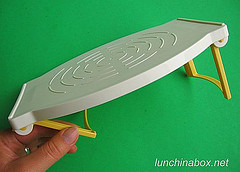
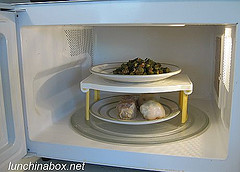
I’ve found a few different stands and plate covers that let you stack plates and bowls on top of each other in the microwave or refrigerator. I keep them next to the microwave and reach for them every day — the covers are faster than reaching for plastic wrap when nuking even a single plate of food, and the plastic doesn’t touch the food directly. An added benefit is that they’re reusable and reduce kitchen waste. I happened to pick them all up at at the Daiso discount store in Daly City, CA (branches internationally) because at US$1.50 they’re cheap there, but you can also find these sorts of microwave plate covers on Amazon in different designs. (Read on for more microwave covers and lunch packing details.)
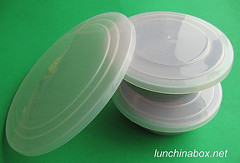 One is a little plastic tray with folding legs; there’s no metal in the hinges so it’s safe for the microwave. Larger plates can go on the top, while smaller plates and bowls fit underneath. It’s 9 3/8″ wide (24 cm), 7.5″ deep (19 cm), and 3.5″ high (9 cm).
One is a little plastic tray with folding legs; there’s no metal in the hinges so it’s safe for the microwave. Larger plates can go on the top, while smaller plates and bowls fit underneath. It’s 9 3/8″ wide (24 cm), 7.5″ deep (19 cm), and 3.5″ high (9 cm).
Other alternatives are hard plastic bowl and plate covers that replace plastic wrap and let you stack things in the microwave or refrigerator. These flat covers come in two different sizes. The smaller one is about 5.5″ in diameter (13.5 cm), and the larger one is 7 7/8″ (20 cm), with ridges in the middle to fit smaller bowls. The manufacturer points out that depending on the size and shape of the bowls you’re using, turning the covers upside down may provide more stability when stacking.
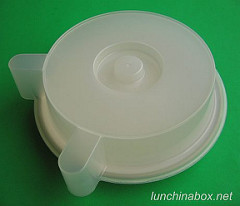 Another option for larger bowls or medium-size plates is a raised plate cover with a half-inch lip around the outer edge. It can be used as either a bowl cover for food that sticks up above the rim of a large bowl, or as a platform to stack another plate or bowl on top for double-decker microwaving. The funny little legs sticking out on the left provide stability when odd-shaped plates are balanced on top, and double as steam vents when microwaving. It’s 8 5/8″ (22 cm) in diameter and about 2″ (5cm) high, with a little built-in knob on top for easy removal. I’ve had this and the flat covers above for at least a year now; they’re really handy and work better in my kitchen than fitted silicone covers or other reusable soft plastic covers that look like showercaps. I find them faster and easier to clean as they can go into the dishwasher.
Another option for larger bowls or medium-size plates is a raised plate cover with a half-inch lip around the outer edge. It can be used as either a bowl cover for food that sticks up above the rim of a large bowl, or as a platform to stack another plate or bowl on top for double-decker microwaving. The funny little legs sticking out on the left provide stability when odd-shaped plates are balanced on top, and double as steam vents when microwaving. It’s 8 5/8″ (22 cm) in diameter and about 2″ (5cm) high, with a little built-in knob on top for easy removal. I’ve had this and the flat covers above for at least a year now; they’re really handy and work better in my kitchen than fitted silicone covers or other reusable soft plastic covers that look like showercaps. I find them faster and easier to clean as they can go into the dishwasher.
- Packing separate containers of a thermal lunch jar full of rice and curry to be eaten separately
 My three-year-old complains about the rice lid method (#1, shown at left) as food tends to spill out when he tries to stir everything up himself (we’re talking preschooler coordination here, folks!). There’s no microwave at Bug’s preschool, so the donburi bento box (#2) doesn’t do him much good. Option #3 leaves Bug with room temperature rice, which is not the end of the world or anything, but it’s difficult for him to combine the rice and stew in the small food jar we have.
My three-year-old complains about the rice lid method (#1, shown at left) as food tends to spill out when he tries to stir everything up himself (we’re talking preschooler coordination here, folks!). There’s no microwave at Bug’s preschool, so the donburi bento box (#2) doesn’t do him much good. Option #3 leaves Bug with room temperature rice, which is not the end of the world or anything, but it’s difficult for him to combine the rice and stew in the small food jar we have.
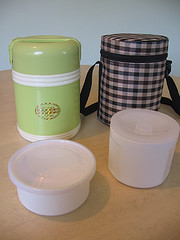 A combination of the donburi bento box and #4 is closest to what I did with this lunch, but I only filled the thermal lunch jar’s big rice container about a third full of rice, and the top container half full of curry and rakkyo. This way Bug was able to open his lunch, pour all of the warm curry right on top of the rice in the big container, and eat it all with a spoon. The rice wasn’t soggy because it had been kept separate from the curry until right before eating, and both rice and curry were warm without a microwave.
A combination of the donburi bento box and #4 is closest to what I did with this lunch, but I only filled the thermal lunch jar’s big rice container about a third full of rice, and the top container half full of curry and rakkyo. This way Bug was able to open his lunch, pour all of the warm curry right on top of the rice in the big container, and eat it all with a spoon. The rice wasn’t soggy because it had been kept separate from the curry until right before eating, and both rice and curry were warm without a microwave.
I packed the lunch in a cheap knockoff thermal lunch jar with only two inner containers, available at Kamei and many Chinese discount stores in San Francisco. It’s about the same size as the Ms. Bento, but smaller than a Mr. Bento or its cheaper but good quality Nissan Thermos equivalent
shown below. Quality and heat retention of the small knockoff is not as good as the Mr./Ms. Bento or the Nissan Thermos, but at $8 it’s a nice option for smaller lunches.
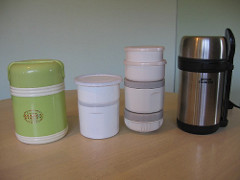 Verdict: Big thumbs up; Bug ate up everything at preschool. He got worried when he saw me reaching for the large lunch jar in the morning, thinking it would be too much. But he was fine with it once I explained that it would only be packed partway with food, and showed him how to pour the curry over the rice. I wound up repeating this lunch again later in the week to use up the leftover curry and rice, but no complaints from Bug as it’s one of his favorites.
Verdict: Big thumbs up; Bug ate up everything at preschool. He got worried when he saw me reaching for the large lunch jar in the morning, thinking it would be too much. But he was fine with it once I explained that it would only be packed partway with food, and showed him how to pour the curry over the rice. I wound up repeating this lunch again later in the week to use up the leftover curry and rice, but no complaints from Bug as it’s one of his favorites.
(Disclaimer: I have no commercial affiliations with Daiso. Amazon links are affiliate links that give Lunch in a Box pennies on the dollar when you use them to get to Amazon when shopping.)
FURTHER READING:
- The “rice lid” method for packing curry or stew in a thermal food jar
- Master recipe for Thai curry
- How to care for your bento gear
- Biggie’s list of top speed tips, tutorials and equipment reviews





Recent Comments
Poll: What bento information interests you? (29)
Jenifer |
FAQRichard Malakuskie | The Nerdie Birdie | Shaking up the Lunch Routine: Popcorn with Toppings - Popcorn Blog | Justin Wright |
Oshibori: We don’t need no stinking wet wipes!Daniel |
Homemade gnocchi box lunches (22)Lisa |
Guide to choosing the right size bento box (82)Julie |
Confessions of an ostrichBernice |
Top Tips (4)miamidish.net | Cheap Seat Eats |
How to make Spam Musubi (69)Scratching Ramen |
School auction bentos with stuffed mushrooms (8)Marci |
Speed Bento: leftover storage and portion guidelinesAdverbios de tiempo |
Fried Shrimp Bentos: Simple vs. Fancy (43)Mimi |
Fruit cup jello jigglers in everyday containers (42)Madison Moms Blog |